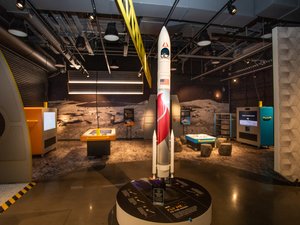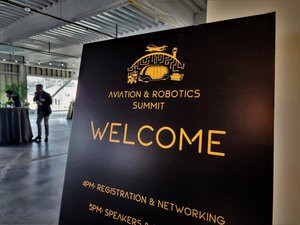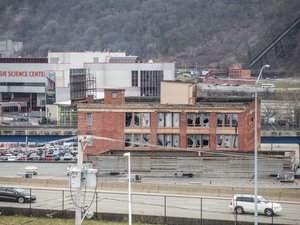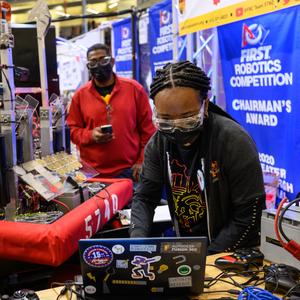By nearly all accounts and on many occasions, Astrobotic Technology Inc. was destined to fail.
Launched as a Carnegie Mellon University spinout in 2007 to compete for Google’s Lunar X Prize, the aerospace company faced out-of-this-world-sized challenges from day one.
After all, the tiny Pittsburgh startup was competing in a field where only organizations backed by billionaires had succeeded before. That made it hard to both secure private-sector partners and land outside investment.
In one instance, Astrobotic CEO John Thornton recalled a time several years ago when a pitch for funding at the 3 Rivers Venture Fair had a member of the audience voice audible laughter that could be heard by those in attendance.
But despite all of this, the company soldiered on, ebbing and flowing from time to time but now ready to launch its signature product.
It has entered the final stages of taking the U.S. back to the surface of the moon for the first time in 50 years, with Astrobotic’s Peregrine Lunar Lander tentatively set to depart onboard United Launch Alliance’s Vulcan Centaur rocket at the Cape Canaveral Space Force Station in Cape Canaveral, Florida, sometime this summer. Its destination: The moon.
If successful, the landing of Peregrine and its 26 different payloads from NASA and private parties will be a monumental achievement not only for Astrobotic, but also for Pittsburgh and the country as well. But even if all doesn’t go according to plan, the North Side-based aerospace company is bullish on its plans to continue serving as a key partner for NASA and others that are looking to get payloads to the moon and beyond.
“We’re a 16-year overnight success story,” Thornton said. “And space companies are not supposed to succeed in Pittsburgh. If you start a space company, you’re supposed to be in Florida or Texas or California, and you’re supposed to have a billionaire behind you. We didn’t have any of that. We’re starting in a non-fertile ground here in Pittsburgh, and we did it anyway. … Pittsburgh is quite literally leading our nation back to the surface of the moon, and that’s something the whole city should be proud of.”
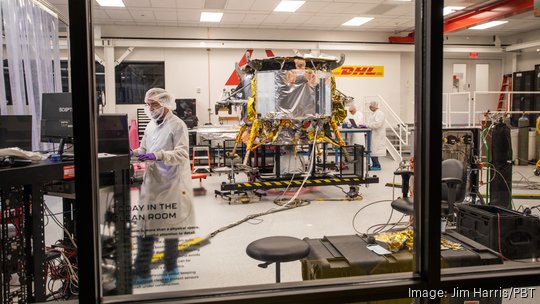
The recipe for liftoff
Astrobotic’s origins begin like those of many Pittsburgh startups — behind the scenes at CMU.
There, William “Red” L. Whittaker, Fredkin University Research Professor of Robotics and director of the Field Robotics Center, has had an influence on just about every robotics-based company in Pittsburgh.
A titan of the industry, Whittaker led CMU’s Tartan Racing Team as a faculty member in 2007 to a first place and subsequent $2 million victory in the third annual DARPA Grand Challenge, a race of robotics-based driverless vehicles that saw many of its student participants go on to launch autonomous vehicle companies of their own.
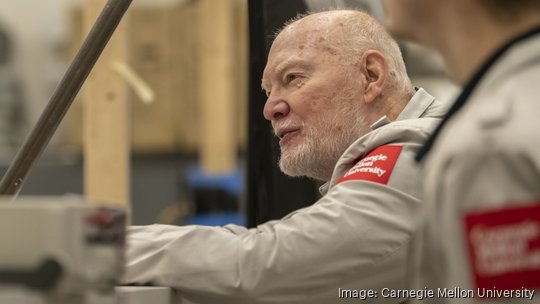
It was right after this race that Whittaker founded Astrobotic to compete in the Google Lunar X Prize competition, which looked to award $20 million to the first team that landed a robot on the moon that could then travel 500 meters on the lunar surface while taking and sending images and other data points back to Earth.
Whittaker said the fostering of companies like Astrobotic and those that have emerged after the DARPA Grand Challenge are the result of a tried four-step approach that starts with forming companies that have a distinct excellence or edge followed by a clear ability to scale, a 10-year or longer timeline and entrepreneurial intent.
“I always said that my model in life is to get these things going and do the hard pioneering when there’s not a nickel to work with,” Whittaker said. “Grind it out of nothing, build it to greatness, get the game going, get the money flowing and get some great people in there. And then at that stage of the game, evaporate. Disappear. Go like you were never there.”
And that’s exactly what Whittaker did.
After setting Astrobotic up with some initial seed funding, largely through grants from the U.S. Small Business Innovation Research program, he sold off all of his founding stock, and, as part of his act in doing so, stipulated that Astrobotic be an employee-owned firm. About 85% of the company’s assets today are owned by its roughly 210 workers as a result of his requirement.
“My play: I don’t need a nickel. God bless, go forth, do well, really make something out of this,” Whittaker said. “At some point in life, you get the idea of what you’re really about and I’ve had, for whatever coincidences, a pioneering edge, innovative advantages of the robotics movement at Carnegie Mellon and so many great, great, great people here who would pick up on this inclination to push it in the world and then get out there and do the kinds of things we’re talking about.”
Thornton, a CMU student at the time, was one of such “great people” hinted at by Whittaker.
He first joined Astrobotic in 2007 as an engineer, back when a different business plan for the company was underway. It was then that Astrobotic was looking to primarily focus on gathering data from the moon but with models that “didn’t quite work,” Thornton said.
At one point, the company dolled out pink slips to everyone, Thornton included, though he and a few others were ultimately spared a few days before widespread terminations took place.
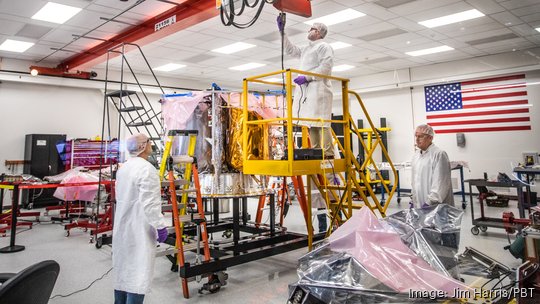
By 2012 and while still in a period of struggle, Thornton took on the role of CEO and refocused the company’s revenue sources to focus on getting contracts through NASA and other sources. But at one point while under his leadership, a few key contracts fell through, and it was Thornton and three others at a table who had to decide if the company could continue after laying off workers.
“We looked around each other and said, ‘well, can we keep this going?’ And we decided to do it,” Thornton recalled. “I think it’s really the passion that drives us and the passion that keeps us going, ‘cause that’s what you got to have to get through the bad days. And that was a bad day.”
The tides began to turn after that day. The company first convinced Congress and NASA to create a program called Commercial Lunar Payload Services (CLPS) with the idea of sending commercial payloads to the surface of the moon. It then won the first CLPS bid.
Astrobotic eventually managed to convince enough people in the private sector that serving as one of NASA’s dedicated cargo operators is a business model that will grow in the years to come. Obtaining about $500 million in NASA contracts since its origins has helped defend that claim, of course, but so too has the growing belief that the final frontier is once again starting to be pursued at interest levels that were last seen at the genesis of the Space Race of the mid-20th century. CLPS, after all, is part of NASA’s broader Artemis program, a robotic and human moon exploration initiative that’s aiming to put humans back on the lunar surface by the end of the decade.
“In this golden era of exploration, NASA is working with partners like Astrobotic to do what’s never been done before — successfully landing American commercial payloads on the lunar surface. NASA’s CLPS missions will deepen our understanding of the moon and help develop the tools and technologies to take humanity’s next giant leap: Sending the first humans to Mars,” said NASA Administrator Bill Nelson in an email statement.

Ready Mission One
Since 2017, Astrobotic’s headquarters on the North Side has been the site of Peregrine’s construction, assembly and testing.
The lander, standing just over six feet tall and eight feet wide, has a payload weight of around 200 pounds and features solar panels for power generation. Comprised mostly of aluminum and carbon fiber, it is equipped with navigation sensors, avionics systems, communications equipment and 26 payloads from six different countries on board, which range in size from a physical, quarter-sized bitcoin to small rovers that are under half a meter in width, height and length. Astrobotic, which declined to disclose revenue, began offering payloads at a pricing model of $1.2 million per kilogram.
After its ejection from the ULA rocket, Peregrine will travel on its own from just beyond Earth’s atmosphere to the surface of the moon, a trip that spans nearly 240,000 miles and will take almost exactly a month to complete. Astrobotic’s North Side mission control center, decked out with computers, massive displays and other control mechanisms for about 30 people to operate, will see that trip and Peregrine’s planned landing on the moon through.
Since Peregrine lacks the ability for a return trip to Earth, it will permanently occupy the lunar surface after touching down from its maiden voyage, known internally as Mission One. In the future, the Peregrine model will be deployed for the transportation of heavier payloads during subsequent missions.
One payload that will be onboard this time is the two-kilogram, shoebox-sized Iris Lunar Rover, which was built by a team of about a dozen students, staff and professors at CMU. It will become the smallest and lightest rover to enter space and the first American-made robot to land on the moon. Once there, it’ll be remotely operated from the newly built Moonshot Mission Control, which spans two rooms within the Gates Center for Computer Science on CMU’s campus.
Thornton said he’s preparing for a lot of weird emotions come Peregrine’s launch day.
“Ultimately, 16 years of my life have been dedicated to this; lots of blood, sweat and tears, and who knows what happens,” he said. “It could be successful, it could be a failure, but either way, we will have overcome so many things to get to where we are today. It’ll be a big moment just to be on the launch pad and about to fly something toward the moon.”
Next steps and leaps for Astrobotic
In many ways, Astrobotic is just getting started following Peregrine’s first flight.
Already, Astrobotic’s development efforts extend beyond Peregrine, as the company is also working on Griffin, a lander that will deliver NASA’s water-detecting rover VIPER to the moon in 2024.
When it’s finished, Griffin will be about four times the size of Peregrine and capable of transporting much larger payloads. It’s being built inside the same clean room that Astrobotic engineers built Peregrine in at Astrobotic’s headquarters, which also features an array of testing environments and physical simulation space for spacecraft.
“That lander is the biggest lander of any kind since Apollo, bigger than all the Mars landers, really,” Thornton said. “It’s massive.”
CubeRover also is in development by the company. It’s a small 40-centimeter by 50-centimeter by 28-centimeter four-wheeled vehicle capable of transporting up to six kilograms of mass, which will cost companies, governments, nonprofits or individual customers $4.5 million per kilogram of mass that is attached to the rover. Astrobotic envisions shipping CubeRovers onboard future lander missions following Peregrine’s first trip.
In the future, the company also has plans to provide sustained power to the moon with permanent electricity, and it could do so by 2028 if all goes according to schedule.
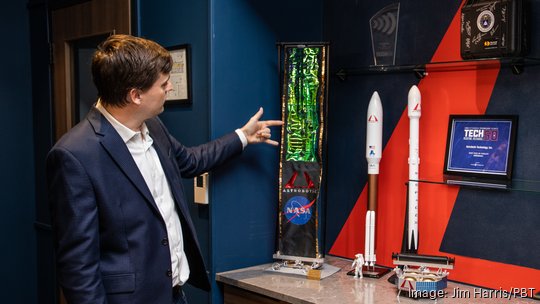
LunaGrid, an electric generation and distribution service, aims to provide power to various lunar surface systems, such as rovers, landers, science suites and habitats, by the watt. It’ll do so through a combination of Astrobotic’s rovers, landers and wireless chargers, as well as its vertical solar array technology (VSAT), which is being developed in collaboration with NASA to enable mobile solar energy capture. By working in concert with one another, LunaGrid’s various components will allow others to tap into what Astrobotic hopes will be uninterrupted power.
Here’s how it would work: The wireless chargers and rovers — tethered to a VSAT system — will act as mobile outlets. Meanwhile, the VSAT systems chase the sun along the moon’s southern pole. With such a configuration, Astrobotic envisions its solar-powered system will be able to avoid the lunar night, which lasts for 14 Earth days and has temperatures that plunge hundreds of degrees Fahrenheit below zero.
“Pittsburgh could potentially operate the power grid of the moon. And if we can do that, then we can support astronauts and recharge astronauts’ suits down on the surface of the moon,” Thornton said. “We could recharge their suits, recharge their tools, recharge their equipment. You can also use that power to potentially go down into permanently shadowed craters and extract water that you could drink and you could turn into oxygen to breathe and you could potentially, most importantly, take that water and split it and turn it into rocket fuel … and if you can create rocket fuel on the moon, then you can really start to use the resources of the moon for Earth purposes.”
Thornton is optimistic that LunaGrid and other ambitious programs currently underway will be carried out during his tenure at the helm of the company.
A new frontier for Pittsburgh
Astrobotic’s triumphs will likely lead to those for others locally, too.
“If Pittsburgh can land on the moon, Pittsburgh can do anything,” Thornton said. “I think this is the exclamation point to the transformation of the city. We are no longer an old dirty steel town, right? We are the next generation of the tech economy, and the opportunities here are limitless. We’re going back to the roots to build the foundation of what this is today and kind of taking that next step. This is our coming out party of sorts for Pittsburgh.”

The space industry certainly is a growing one: A May 2022 report from CNBC citing analysts from Citigroup Inc. found that the global space industry is expected to hit $1 trillion in revenue by 2040. It surpassed $424 billion back in 2020. And that presents opportunities for Pittsburgh.
“The success of Astrobotic is emblematic of the growing robotics, aerospace and autonomous vehicle industry in southwestern PA,” said Matt Holjes, managing director of sales and marketing at Catalyst Connection, a local nonprofit manufacturing consulting firm. “As these tech-centric companies reach maturity and the industry reaches critical mass, regional manufacturers are positioning themselves in these rapidly growing supply chains. Manufacturers with experience in material science, precision machining and forming, additive manufacturing and rapid prototyping are uniquely suited to meet the needs of this growing market segment.”
Astrobotic, which has resisted the urge to relocate despite offers from other markets, has not revealed the names of the companies it partners with to produce its spacefaring components, but it has disclosed that it collaborated with over 100 firms to build and transport Peregrine, and that it prefers to work with local businesses when feasible for such efforts.
“We have so many more companies beyond Astrobotic doing space work here, and that’s the stories that we want to tell,” said Keystone Space Collaborative Founder and Board Chair Justine Kasznica, who is also a shareholder and chair of the emerging technology practice group at Babst Calland. “We want to make sure that in the next three to five years, this region becomes known as a space industrialist that is hearkening back to our industrial manufacturing past. It ties in with our interest in rebuilding this region around new frontier technology and innovation. And space offers that in droves.”
Pennsylvania Gov. Josh Shapiro is also bullish on Astrobotic and the space tech sector in the state. The commonwealth over the years has invested in Astrobotic via tax credits and grants, something Shapiro is hoping will continue as part of his administration’s priorities during his tenure.
“I believe in John’s vision. I believe in the power and the potential of the Commonwealth of Pennsylvania to be leaders when it comes to space,” Shapiro said to a crowd of about 300 during the kickoff event for the inaugural Aviation & Robotics Summit in the Strip District on April 18. “I believe that this is the place where we need to plant our flag and expand and explore new horizons.”
As for Whittaker, he couldn’t be more thrilled about how far the company has come and where it’s going.
“I am so proud of these guys, I am almost dripping in tears when I say that, and I’m not so sure I ever said it to them,” Whittaker said. “When you do things like this together, it’s a bond for life. And given that I turned 75 this week, it gives me life. … I think Astrobotic will also be the one to transform beliefs with some of the most imaginative missions yet to come.”
